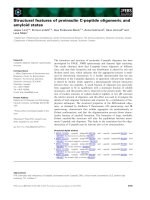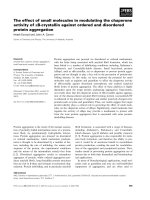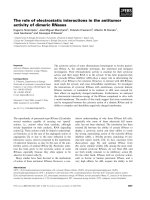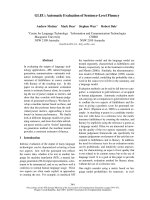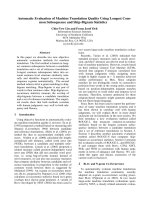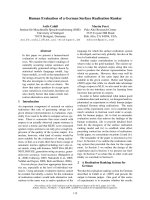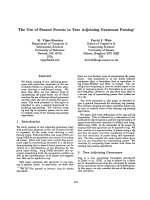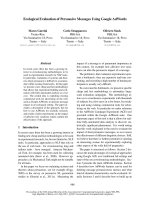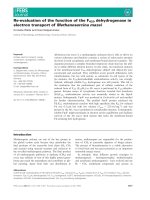Báo cáo khoa học: " Experimental evaluation of pathogenicity of Lactococcus garvieae in black rockfish (Sebastes schlegeli)" pptx
Bạn đang xem bản rút gọn của tài liệu. Xem và tải ngay bản đầy đủ của tài liệu tại đây (388.64 KB, 4 trang )
-2851$/ 2)
9H W H U L Q D U \
6FLHQFH
J. Vet. Sci.
(2004),
/
5
(4), 387–390
Experimental evaluation of pathogenicity of
Lactococcus garvieae
in black
rockfish (
Sebastes schlegeli
)
Sung-hyun Kang
1
, Gee-wook Shin
1
, Yong-seung Shin
1
, Palaksha K. J.
1
, Young-rim Kim
1
, Hyang-hee Yang
1
,
Eun-young Lee
1
, Eung-goo Lee
1
, Nam-eung Huh
1
, Oh Myung Ju
2
, Tae-sung Jung
1,
*
1
Institute of Animal Medicine and College of Veterinary Medicine, Gyeongsang National University, Jinju 660-701, Korea
2
Department of Fish Pathology, Yosu National University, Yosu 550-747, Korea
Black rockfish (
Sebastes schlegeli
) is an important
mariculture species in Korea. The production of this fish is
drastically declined due to bacterial diseases, particularly
streptococcosis caused by
Lactococcus garvieae
. The
bacterial surface characteristics of SJ7 and TY6 were
found to have capsule but not NB13 and YS18. The
experiential evaluation of
L. garvieae
pathogenicity, the
capsular isolates showed high cumulative mortality i.e.
SJ7 (100%) and TY6 (60%) compared to non-capsular
isolates. Based on this result the capsular isolates
L.
garvieae
were highly suspected as the causative agent of
streptococcosis in rockfish.
Key words:
Lactococcus garvieae
, Black rockfish (
Sebastes
schlegeli
), mariculture
Aquaculture, especially mariculture, has become one of
the major food producing sectors in Korea [1,14,16].
Among mariculture fishes, black rockfish is a very
important species in the point of view of consumer’s
preference and as well as its compatibility with flounder in
polyculture. The production of black rockfish was recorded
up to 16,548 M/T, contributing about 45% of the total
mariculture fish production in Korea (2002 Statistics,
Ministry of Maritime Affairs & Fisheries, Korea).
Since a decade the mariculture industry in Korea is facing
a serious problem of outbreak of several bacterial diseases,
particularly, streptococcosis.
Lactococcus garvieae
has been
reported as one of the major causative agent of streptococcosis
or lactococcosis in fish [2,3]. The ubiquitous nature
(sediment, water) and capability of horizontal transmission,
the pathogen has become real biological threat to
development of black rock fish farming industry. It is also
reported to infect fishes [4,9,10,15,19,20,22], avian [5],
water buffalo [21], and human [11,12,13].
L. garvieae
infected fishes exhibit a variety of clinical
signs, such as anorexia, exophthalmia, melanosis, conjunctivitis,
erect swimming, severe internal hemorrhage and congestion
of blood vessel, peritonitis, abscess of spleen and liver,
meningoencephalitis, and bacterial septicemia [4,9,10,15].
The similar clinical signs were also reported from the fish
farms subjected to disease outbreak due to
L. garvieae
infection. In this context, the present study was carried out to
evaluate the pathogenicity of
L. garvieae
isolated from the
diseased olive flounder (
Paralichthys olivaceus
) to rockfish.
The four isolates of
L. garvieae
(Table 1) were isolated
from diseased yellowtail and olive flounder collected from
different locations in Korea. Isolates were stored in Tryptone
Soya Broth (TSB; Oxoid, England) with 0.5% yeast extract
(BD, Sparks, USA) and 20% glycerol at
−
80
o
C until use.
L.
garvieae
strain KG (-) 9408 was kindly provided from Dr.
Ooyama, Japan and stored as the above. The pathogenicity
of bacteria in combination with electronic microscopic
studies revealed that the capsular envelop of
L. garvieae
KG
(-) was more virulence than either micro- or non-capsular
L.
garvieae
KG (+) [18]. All the Korean isolates in the present
study were identified as
L. garvieae
with API
®
20 Strep kit
(BioMereux, France) and Polymerase Chain Reaction
(PCR) with primers specific for
L. garvieae
16S rDNA
sequence [6,9,21,23]. After thawing, the bacteria was
inoculated to Tryptic Soy Agar (TSA; BD) and incubated at
25
o
C for 24 hrs, and the bacterial colonies on TSA were
*Corresponding author
Tel: +82-55-751-5822; Fax: +82-55-751-5803
E-mail:
Short Communication
Table 1.
Isolates and type strains of
L. garvieae
used in challenge
experiments
Strain
number
Hosts
Year of
isolation
Country
SJ7 Flounder 2001 Korea
TY6 Flounder 2001 Korea
NB13 Flounder 2001 Korea
YS18 Yellowtail 2001 Korea
KG (-) 9408 Yellowtail 1998 Japan
388 Sung-hyun Kang
et al.
transferred to TSB and incubated for overnight at 25
o
C. This
broth containing
L. garvieae
was used for challenge
experiment and antibody production.
Agglutination test was employed to characterize
L.
garvieae
isolates and compared the existence of capsule
between the isolates with the antisera raised against the
L.
garvieae
strains
KG (-) and KG (+). The test was performed
using microplate assay developed by Ooyama
et al
. [18].
One hundred
µ
l of bacterial broth culture (1×10
9
CFU ml
−
1
)
was washed with PBS twice and distributed in 96 well
plates. This plate was then incubated 50ìl of rabbit anti-KG
(-) 9408 and anti-KG (+) sera (1 : 50) by two fold for 1 hr at
37
o
C or overnight at 4
o
C. The results were recorded by
comparing with control, the bacteria incubated with PBS
instead of antisera.
Black rockfish of average weight 20 g were purchased
from a commercial fish farm located at Nam-hea County,
and then transferred to fish challenge room. These fishes
were divided into 5 groups 10 each and acclimatized to
room condition in the tank with 10L of seawater in flow-
through system for three days and fed with commercial
pellet. After treating the fishes with anesthesia AQUI-S
®
(5% Isoeugenol, 0.3 ml/L; AQUI-S New Zealand LTD, New
Zealand), each group of rockfish was injected intraperitoneally
(IP) with 100ìl of four
L. garvieae
isolates (1×10
7
CFU ml
−
1
)
and control group with sterile PBS. The fishes were
maintained at 18
o
C, and monitored for clinical signs and
mortality for 25 days. The moribund and dead fishes were
collected and subjected to indirect fluorescent antibody test
(IFAT) and PCR to identify the bacterial isolates.
The broth cultures of
L. garvieae
isolate KG (-) 9408 was
centrifuged and the pellet resuspended in PBS, inactivated
with formalin to a final concentration of 0.3% and stored at
4
o
C for 24 hr. The suspension was washed with PBS and
adjusted by spectrophotometer as optical density (O.D.) 1.0
at 540 nm corresponding to 1×10
9
CFU ml
−
1
. Five month old
chickens were immunized subcutaneously (S.C.) on legs
with 1×10
9
CFU
of the
formalin killed
L. garviae.
The
bacteria
were mixed with Freunds complete (1st immunization)
and incomplete adjuvant (2nd and 3rd immunization) and
injected at 2-week-interval, and a booster dose was given
after 2 weeks. After 8 weeks of immunization, chicken IgY
was purified from chickens eggs using EGGstract
®
IgY
purification kit (Promega, USA). The purified chicken IgY
was stored at
−
20
o
C until use.
Moribund/dead fishes were dissected and collected either
spleen or head kidney, cut with sharp scalpel, stamped the
cut side on cleaned slide, and fixed it with 100% methanol
for 5 min. The stamped area was marked with nail banish
and incubated with 1 : 200 of dilution of chicken IgY raised
against
L. garvieae
for 30 min at 37
o
C, washed the slide with
PBS three times, incubated with 10
µ
l of fluorescein
isothiocyanate (FITC) labelled anti-chicken IgY (Jackson
ImmunoResearch Laboratories, USA) diluted (1 : 100) in
humidity chamber for 30 min at 37
o
C. After washing the
slide thoroughly with PBS, 100
µ
l of 25% glycerol solution
was added and observed under the fluorescent microscope
(Axioskop, Karl-zeiss, Germany) for bacteria.
PCR technique was also used to identify
L. garvieae
bacteria isolated from moribund/dead fishes [23]. The
bacterial DNA was extracted by adding 20
µ
l of Gene
releaser (Bioventures, USA) in accordance with manufacturer’s
protocol. The amplification of the extracted DNA of the
isolates was carried out by
L. garvieae
16S rDNA gene
specific primers,
pLG-1 (5'-CATAAC AATGAG AATCGC-
3') and pLG-2 (5'-GCACC CTCGC GGGTTG-3') with
programmable heating incubator (PTC-100, MJ Research
Inc., USA). The amplification steps include initial
denaturation at 94
o
C for 5 min, followed by 35 cycles of
each consisting of a denaturation at 94
o
C for 30 sec,
annealing at 55
o
C for 1 min, extension at 72
o
C for 45 sec
plus final extension for 5 min at 72
o
C after 35 cycles. The
amplified product was maintained at 4
o
C for 5min using kit
(AccuPower
®
HL PCR PreMix, Bioneer, Korea) and
electrophoresed in 1.2% agarose gel at 50 V till the dye
reaches the end of the gel. The specific bands on mini-gel
apparatus were recorded by Polaroid image capture with
ECL
TM
mini camera (Amersham Bioscience, Sweden). DNA
from KG (-) 9408 was used as positive control.
Streptococcus
iniae
was used as negative control.
In the agglutination test, except one out of four bacterial
isolates (TY6), all other isolates (SJ7, NB13 and YS18)
were agglutinated by rabbit anti-KG (-) sera at the dilution
of 1 : 100, 1 : 200, and 1 : 800, respectively. Isolates NB13
and YS18 were also agglutinated with rabbit anti-KG (+)
sera at the dilution of 1 : 1,600 and 1 : 200, respectively,
whereas the isolates SJ7 and TY6 could not agglutinate with
rabbit anti-KG (+) sera. Agglutination test was very useful
to characterize phenotype
of
L. garvieae
since the
phenotype of the pathogens were divided into KG (-) and
KG (+) phenotype cells by anti-KG (+) sera. KG (+)
phenotype cells were agglutinated by anti-KG (+) sera,
F
ig. 1.
Comparison of cumulative mortality of rockfi
sh
c
hallenged with
L. garvieae
Korean isolates. Fishes we
re
i
njected intraperitoneally (IP) with
L. garvieae
isolates (1×1
0
7
C
FU fish
−1
). The cumulative mortality was monitored for 25 da
ys
a
t 18
o
C.
Challenge test of
Lactococcus garvieae
389
while KG (-) phenotype cells were not agglutinated by anti-
KG (+) sera [18,22]. However, both KG (+) and KG (-)
phenotype cells were agglutinated when anti-KG (-) sera
was introduced [18,19]. According to the agglutination test,
both NB13 and TY18 were regarded as KG (+) phenotype
cells while both SJ7 and TY6 were thought as KG (-)
phenotype cells.
In the challenge studies, after 15 days of post infection
fishes exhibited a variety of clinical signs such as abnormal
behavior; anorexia, wandering around corner, erect swimming,
severe conjunctivitis, melanosis leading mass mortality.
There was a significant difference in the mortality of fishes
challenged with different bacterial isolates and the control
group. Highest mortality was observed from the fishes
challenged with isolates SJ7 followed by TY6 and NB13&
YS18 at the rate of 100, 60 and 20%, respectively, in 10-20
days of post infection. The IFAT and PCR could detect
bacterial pathogen in the internal organs of the fishes
challenged with all the four bacterial isolates SJ7, TY6
NB13 and YS18 (Fig. 1-2).
This study clearly showed that the capsular
L. garvieae
isolates are highly pathogenic to black rockfish, and the
pathogens are expected to be the causative agents of
streptococcosis not only olive flounder but also black
rockfish. Moreover, outbreaks of streptococcosis caused by
L. garvieae
in either olive flounder or rock fish might infect
nearby fish farms either olive flounder or rock fish.
Acknowledgments
This work was supported by grant No. (R01-2001-000-
00242-0) from the Basic Research Program of the Korea
Science & Engineering Foundation.
References
1. Bai SC, Kim KW. Present status and future prospects of
aquaculture in Korea. World Aquacult 2001, 32, 28-32.
2. Barnes AC, Guyot C, Hanse BG, Mackenzie K, Horn MT,
Ellis AE. Resistance to serum killing may contribute to
differences in the abilities of capsulate and non-capsulated
isolates of
Lactococcus garvieae
to cause disease in rainbow
trout (
Oncorhynchus mykiss L.).
Fish Shellfish Immunol
2002, 12, 155-168.
3. Barnes AC, Young FM, Horne MT, Ellis AE,
Streptococcus iniae
: serological differences, presence of
capsule and resistance to immune serum killing. Dis Aquat
Organ 2003, 53, 241-247.
4. Carson J, Gudkovs N, Austin B. Characteristics of an
Enterococcus
-like bacterium from Australia and South
Africa, pathogenic for rainbow trout (
Onchorynchus mykiss
Walbaum). J Fish Dis 1993, 16, 381-388.
5. Che SC, Lin YD, Liaw LL, Wang PC.
Lactococcus
garvieae
infection in the giant freshwater prawn
Macrobranchium rosenbergii
confirmed by polymerase chain
reaction and 16S rDNA sequencing. Dis Aquat Organ 2001,
45, 45-52.
6. Collins MD, Ash CJ, Farrow AE, Wallbanks S, Williams
AM. 16S ribosomal ribonucleic acid sequence analyses of
lactococci and related taxa. description of
Vagococcus
fluvialis
gen. nov., sp. nov. J Appl Bacteriol 1989, 67, 453-
460.
7. Collins MD, Farrow FAE, Phillips BA, Kandler O.
Streptococcus garvieae
sp. nov. and
Streptococcus plantarum
sp. nov. J Gen Microbiol 1984, 129, 3427-3431.
8. Domenech A, Prieta J, Fernandez-Garayzabal JF, Collins
MD, Jones D, Dominguez L. Phenotypic and phylogenetic
evidence for a close relationship between
Lactococcus
garvieae
and
Enterococcus seriolicida
. Microbiologia 1993,
9, 63-68.
9. Eldar A, Ghittino C, Asanta L, Bozzetta E, Goria M,
Prearo M, Bercovier H.
Enterococcus seriolicida
is a junior
synonym of
L. garvieae
, a causative agent of septicemia and
meningoencephalitis in fish. Curr Microbiol 1996, 32, 85-88.
10. Eldar A, Hurvitz A, Bercovier H, Ghittino C.
Lactococcus
garvieae
and
Streptococcus iniae
infections in rainbow trout
(
Oncorhynchus mykiss
): two similar but different diseases.
F
ig. 2. (A) Identification of causative agents from challeng
ed
r
ockfish with IFAT using chicken IgY raised against
L. garviea
e.
(
B). PCR results of the isolated bacteria from challenged fishe
s,
l
ane1: KG (-) 9408 (reference strain); lane 2: SJ7 strain; lane
3:
T
Y6 stain; lane 4: NB13 strain; lane 5: YS18 strain; N: negati
ve
c
ontrol; M: DNA molecular weight marker.
390 Sung-hyun Kang
et al.
Dis Aquat Organ 1999,
36
, 227-231.
11.
Elliott JA, Collins MD, Pigott NE, Facklam RR.
Differentiation of
Lactococcus lactis
and
Lactococcus
garvieae
from humans by comparison of whole-cell protein
patterns. J Clin Microbiol 1991,
29
, 2731-2734.
12.
Fefer JJ, Ratzan KR, Sharp SE, Saiz E.
Lactococcus
garvieae
endocarditis: report of a case and review of the
literature. Diagn Microbiol Infect Dis 1998, 127-130.
13.
James PR, Hardman SMC, Patterson DLH.
Osteomyelitis
and possible endocarditis secondary to
Lactococcus
garvieae
: a first case report. J Postgrad Med J 2000,
76
, 301-
303.
14.
Kim IB.
Cage Aquaculture in Korea. Proceedings of the first
International Symposium on Cage Aquaculture in Asia. In:
Liao IC, Lin CK (eds.), Cage Aquaculture in Asia 2000, pp.
59-73, World Aquaculture Society, Charleston, 2000.
15.
Kusuda R, Kawai K, Salati F, Banner CR, Freyer JL.
Enterococcus seriolicida
sp. nov., a fish pathogen. Int J Syst
Bacteriol 1991,
41
, 406-409.
16.
Lee S, Jeon IG, Lee JY.
Effects of digestible protein and
lipid levels in practical diets on growth, protein utilization
and body composition of juvenile Rockfish (
Sebastes
schlegeli
). Aquaculture 2002,
211
, 227-239.
17.
Lee SB, Mine Y, Stevenson RM.
Effects of hen egg yolk
immunoglobulin in passive protection of rainbow trout
against
Yersinia ruckeri
. J Agric Food Chem 2000,
48
,
110-
115.
18.
Ooyama T, Hirokawa Y, Minami T, Yasuda H, Nakai T,
Endo M, Ruangan L, Yoshida T.
Cell-surface properties of
Lactococcus garvieae
strains and their immunogenicity in
the yellowtail (
Seriola quinqueradiata
). Dis Aquat Organ
2002,
51
, 169-177.
19.
Ooyama T, Kera A, Okada T, Inglis V, Yoshida T.
The
protective immune response of yellowtail (
Seriola
quinqueradiata
) to the bacterial fish pathogen
Lactococcus
garvieae
. Dis Aquat Organ 1999,
37
, 121-126.
20.
Schmidtke LM, Carson J.
Induction, characterisation and
pathogenicity in rainbow trout
Oncorhynchus mykiss
(Walbaum) of
Lactococcus garvieae
L-forms. Vet Microbiol
1999,
69
,
287-300.
21.
Teixeira LM, Merquior VLC, Vianni MCE, Carvalho
MGS, Fracalanzza SEL, Steigerwalt AG, Brenner DJ,
Facklam RR.
Phenotypic and genotypic characterization of
atypical
Lactococcus garvieae
strains isolated from water
buffalos with subclinical mastitis and confirmation of
L. garvieae
as a senior subjective synonym of
Enterococcus
seriolicida
. Int J Syst Bacteriol
1996,
46
, 664-668.
22.
Yoshida T, Endo M, Sakai M, Inglis V.
A cell capsule with
possible involvement in resistance to opsonophagocytosis in
Enterococcus seriolicida
isolated from yellowtail
Seriola
quinqueradiata.
Dis Aquat Organ
1997,
29
, 233-235.
23.
Zlotkin A, Eldar A, Ghittino C, Bercovier H.
Identification
of
Lactococcus garvieae
by PCR. J Clin Microbiol 1998,
36
,
983-985.
